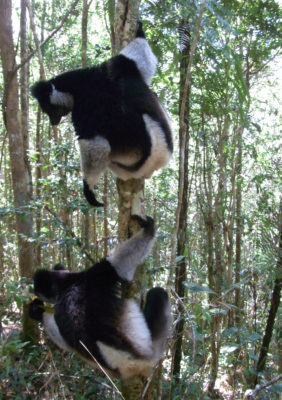Conservation Solutions for Lemurs that Support Habitats and Wildlife
With 98% of lemur species endangered, supporting Madagascar’s habitats and wildlife is fundamental for lemur conservation.
Protected Areas
In protected areas, rules about the use of the forest can be enforced which in turn keeps the forest itself and its wildlife safer. Conservation work in protected areas includes forest monitoring, boundary demarcation, scientific research, ecotourism, conservation education, and maintenance of trails and infrastructure.
Madagascar currently has 116 protected areas covering 6.5 million hectares of land. Visit the Madagascar National Parks website to learn more about these parks and reserves.
Organizations that Help Manage Parks and Reserves

Reforestation to support habitats and wildlife
We wish all of the forests still existed and that we could rely solely on preserving them, but this is not the case. In fact, conservation is not only about preventing things from getting worse, but also taking action to make them better! Restoring habitat is necessary to support the wildlife populations that exist today. And doing so will also allow those populations to grow in the future. Reforestation is the only way to connect forest fragments and replenish habitat that has been lost or degraded.
Reforestation must also have local buy-in, not just conservationist support. Habitat restoration efforts that provide good jobs for people living near the sites develop local pride in new forests. This in turn helps ensure that the areas remain forested. Conservation education is also necessary for reforestation planning. Efforts are much more successful when the people who live near the sites are involved in the work. This is because they understand and appreciate the benefits of reforesting the area.
Organizations Doing Reforestation in Madagascar

Fire Prevention
It is illegal to start fires in national parks and other protected areas. But sometimes, fires started outside of park boundaries get out of control and encroach on forests where lemurs live. Fire prevention and control is extremely important to protect remaining wild habitat.
Organizations Conducting Fire Prevention Work in Madagascar

Addressing the Invasive Species Problem
The stray dog and cat population in Madagascar has serious negative effects on wild species across the island, including lemurs. The Mad Dog Initiative is helping to address this problem in ways that help the dogs, cats, people, and the lemurs.
About Mad Dog Initiative’s Work:
- Capture, spay/neuter, and vaccinate domestic and feral dogs in villages surrounding Ranomafana and Andasibe National Parks
- Work with and train local veterinarians and veterinary students from University of Antananarivo
- Conduct camera trap and lemur transect surveys in forests surrounding these villages
- Conduct surveys of households in villages to investigate the impact of dogs on local wildlife
Reintroduction & Relocation
Similarly to how we cannot rely on forest preservation alone to solve the habitat loss problem, we cannot simply reintroduce or relocate animals to “better” or safer areas and expect them to thrive. Reintroduction is complicated and expensive, but it can work in limited circumstances. Some examples include:
- Madagascar Biodiversity Partnership successfully relocated a group of diademed sifakas to an area where they previously lived (Andasibe). They are now thriving.
- Lemur Rescue Center/ONG Reniala rescues and rehabilitates pet ring-tailed lemurs. Some are released in Reniala Reserve which the organization also manages.
Captive Breeding Programs at Zoos
Captive breeding programs are a huge part of the conservation work done by zoos to protect habitats and wildlife. They can be incredibly important in helping to save species from extinction. These programs build up the population of a species outside of its natural habitat. Populations in captivity act as a safeguard, ensuring that the species does not go entirely extinct even if it does become extinct in the wild. Individual animals at zoos also act as ambassadors for their wild counterparts, helping to educate people around the world about the importance of their species.
